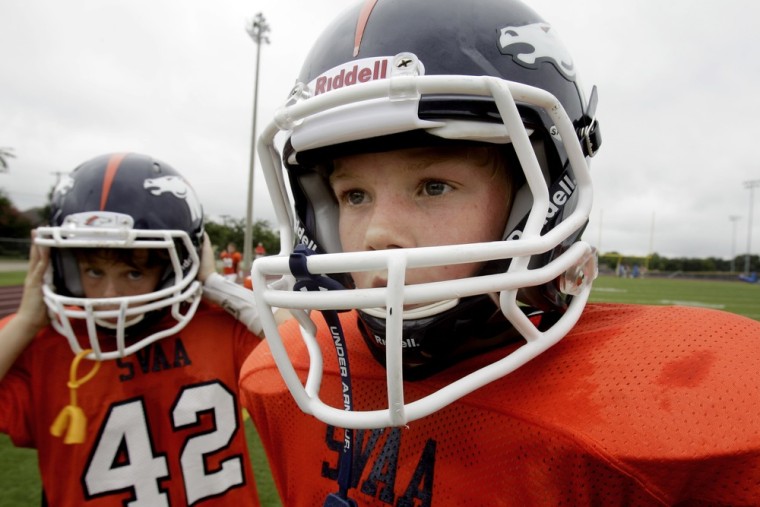The news of the National Football League’s Thursday settlement of $765 million to thousands of players who had sued over head injuries has helped raise awareness of the danger of concussion among those who play the sport.
But does that increase in awareness of head injuries in the sport impact parents who let their kids play youth football, which includes children ages 5 to 15?
While many football parents can’t help but worry when their kids play the sport – after all, you send your kid to battle in a helmet and full gladiator gear – there’s no major indication parental fear is resulting in fewer kids playing, according to current statistics.
Pop Warner, the largest and oldest youth football organization in the U.S., has seen the number of youth players – close to 250,000 – remain steady from 2011 to 2012, according to Josh Pruce, national director of media relations at Pop Warner headquarters in Langhorne, Penn.
And Pruce says in the five years prior to 2012, there was a consistent, steady growth of 1 percent to 2 percent of players each year.
Pruce says that he has seen an increase in questions and concerns about head injuries related to the sport. “It’s something we hear from parents and coaches. But we tell them safety is Pop Warner’s number one priority.”
In 2010, the organization instituted the Pop Warner concussion rule, which demands several steps be taken if a player has a concussion. Among the steps: If a player is diagnosed with a concussion, he has to sit out the rest of the game and can’t come back to practice or play until he is cleared by a doctor.
Also, last year Pop Warner started limiting the amount of contact time during practices and banned the hitting drills that were deemed most dangerous.
In the Seattle area, the Greater Eastside Junior Football Association saw a 3 percent drop in player enrollment – from 2,868 to 2,785 - in the last year, according to Billie Hartline, a GEJFA Council representative. Hartline says he considers it to be a “normal range of fluctuation” and isn’t aware of anything specific causing a drop in players.
Meanwhile, in the football-loving land of south Texas, the past five years has only seen growth, says Chris Martinez, a father of three boys who play football, and president of the South Texas Youth Football League in Corpus Christi.
Martinez said the league, which started in 2009 with 12 teams and 288 kids, has grown to 72 teams and 1,700 kids. And he attributes the growth in part to the attention to safety the league promotes, thanks to an association with USA Football and the NFL.
The league sends coaches to Houston, which is four hours away, for a six-hour mandated training course and they also have to take a four-hour online course, which covers recognizing concussions, among other injuries.
The league’s focus on safety puts parents more at ease, says Martinez, who repeats the mantra, ‘When in doubt, sit him out,” as the league’s standard for dealing with concussions. “It’s great for our parents to see that our coaches have gone through the training. We set our standard so high, we are doing it right.”
A former high school football player, Martinez isn’t immune to worry when his 6-, 8-, and 12-year-old sons get hit on the field.
“As a father, I get really scared. On each play, you can’t help but worry, ‘Wow, what’s going to happen to my sons?’ But it helps knowing our coaches are taught well and the kids are going to learn to tackle correctly, run the ball correctly, and hopefully stay out of harm’s way.”
"I played football growing up. This is the existential threat to the game, though. If parents decide to send their kids into soccer instead of football, it could really hurt the NFL long-term," said TODAY's Willie Geist.
Kirsten Duncan, a Bellevue, Wash., mom of three, has two sons who played football but have quit because of concussions. Her youngest son, Nolan, was in fourth grade when he had a severe concussion from running into a pole at school. Duncan had him tested by doctors in the spring of his fourth grade year, who cleared him to play the following year. “I was on pins and needles every time he played,” she said.
But after that season, Duncan and her husband heard the news that NFL player Junior Seau had committed suicide and that his family blamed brain damage caused by years of repeated concussions.
“After hearing [about Seau], we just realized we didn’t know enough and that we just don’t want to take the chance. It’s not worth it to us,” Duncan said.
Duncan says Nolan now focuses on basketball, but every year during football season he says he misses it. “He loved the camaraderie and the athleticism … there’s such an aura about football. Both of my kids loved it. The whole family did.”
Related stories:
NFL and players reach $765 million settlement over head injuries
